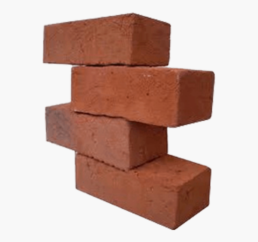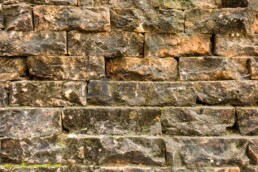BRICKS BY SHAPES
In the history of professional construction practices, brick is one of the oldest of all building materials. It is also arguably the most durable since there are brick walls, foundations, pillars, and road surfaces constructed thousands of years ago that are still intact. Today, bricks are most often used for wall construction, especially as an ornamental outer wall surface.
Brick Defined
Officially, the term brick is used to denote a building unit made of shaped clay, but in modern times it is used to refer to any stone- or clay-based building unit that is joined with cementitious mortar when used in construction. Typically, bricks are about 4 wide, 8 inches long, with a variety of thicknesses. Larger stone- or clay-based building units of the type used in foundations are usually called blocks.
How Bricks Are Categorized
There are several ways that brick can be categorized. For example, you can divide brick into the types used for facing (exposed and visible on the exterior of a structure) vs. backing bricks (which are used structurally and are hidden from view). Another means of categorizing brick is according to how they are manufactured: unfired (brick that is air-cured) and fired (brick that is baked in ovens to harden it). Bricks can be also categorized according to their typical use: common bricks or engineering bricks. For purposes of residential construction, it is usually common bricks that are of most interest, since engineering bricks are more often used in civil engineering projects, such as road or bridge construction, or sewers construction.
Bricks can also be categorized according to their shape. Some common shapes include:
- Brick veneers: These bricks are thin and used for surface cladding.
- Airbricks: These bricks contain large holes to circulate air and lessen weight. They are used on suspended floors and cavity walls.
- Perforated bricks: These bricks contain many cylindrical holes drilled throughout the brick. They are very light in weight.
- Bullnose brick: These are bricks moulded with round angles.
- Paving bricks: These bricks contain a good amount of iron. They are used in underfoot paving applications.
- Capping bricks: These bricks are used to cap the tops of freestanding walls.
- Hollow bricks: About one-third of the weight of the normal bricks, these are used mostly in partition walls where load-bearing is not required.
Automatic Sliding Doors
Automatic sliding doors are designed with attractive framing and sleek styles to complement any entry. Glass sliding doors are ideal when it comes to unobstructed views and allowing natural light into a building.
Where possible for building entrances, use automatic sliding doors activated by a motion detector. These doors also provide an audible cue for people impacted by blindness to the presence of the entrance. Automatic sliding doors don’t impede traffic flow in any way, don’t require guardrails for protection (as automatic non-sliding doors do) and are universally accessible.
If there’s an emergency or power loss, it should be possible to open automatic sliding doors in the direction of exit using a manual force of 66 N or less.
Overhead motion activated sensors are preferred over floor-pad door activation sensors, as the floor-pads are prone to malfunction in winter. If floor-pad door activation sensors are used, they should be installed with the surface of the pad no more than 13 mm above the surrounding ground surface.
If push buttons are used for automatic swing-type doors, each button should open only one door. Push buttons should never open both leaves of a pair of doors. A person should be able to open or stop an automatic swing-type door with a force of 66 N or less.
Where used, push-button or push-plate activated power door operators should be consistently located at all entrances. They should be colour contrasted to the background environment to enhance visibility for people impacted by blindness. Position push buttons/plates so that the opening door doesn’t hit the person opening the door or their guide dog.
Characteristics and Advantages
(1) Automatic sliding door mechanism are available in either single sliding, bi-parting or telescopic configurations.
(2)Modularization design to make installation and adjust more easy;
(3)Adaptable to all types of door frames;
(4)Motor power control system with automatic reversal for user safety;
Automatic Sliding Door System using:
1) 10mm Toughened (Tempered) Frameless Glass Door with Logo Design on Door
2) 5mm Aluminium Framed Glass Door
* Door sizes can be customized
More Powerful
Three roller carriage ensure the door can’t derail from the profile.
European installation design promise its smooth and stable operating.
Rubber damping-washer, advanced synchronous toothed belt and alloy guide roller make sure there is few noise when it works.
Hands free operation is actuated by sensor activation or other automatic activation.
The various operating modes “ Lock, Exist Only, Permanent Open, Half Open, Automatic” can be selected via remote activation ( remote controller).
Unique design remote controller.
When you don’t need to use remote controller, you can power off to increase its working life
Safe Operation
Safety beam sensor protection
Auto-reverse when it meets obstruction. The impact force is less than 67N.
Easy to open by hand after power fails.
It can open at least 80% within 3s after activation by activators if opening width is up to 2000mm.
Battery works after power fails. Door open and keep open or works normally with battery power.
Fuse protection
Electric Fencing
Electric fences are designed to create an electrical circuit when touched by a person or animal. A component called a power energizer converts power into a brief high voltage pulse. One terminal of the power energizer releases an electrical pulse along a connected bare wire about once per second.
Building a good electric fence is like anything else, you get out what you put in. If you use the proper equipment and maintain the fence the result will be a permanent structure just like the barb wire you use to use. The advantage of using ‘electric’ or ‘high tensile’ fences is on average they cost less than a barb wire fence, since less materials are required (ie posts, staples and wire) and they take less time to install. The electric fence option is also more versatile; you can take it down quickly and re-install somewhere else.
HOW DOES THE SOLAR ELECTRIC FENCE SYSTEM WORK?
When an animal or human being comes into contact with the electric Fence, they receive a sharp, short, painful but safe electric shock. The shock does not cause any physical damage. The electric fence acts as a strong psychological barrier as any intruder will avoid coming into contact with the electric Fence once they experience the shock. After a period of conditioning, the mere presence of the fence acts as an effective barrier even if it is not powered ‘ON’. Electric fence can be made to detect a fault on the fence like shorting or cutting of the wire due to tampering on the fence with the Alarm system.
SPECIAL FEATURES OF THE SOLAR ELECTRIC FENCE SYSTEM
Electric Fence can be built alongside existing fences except in case of barbed wire fences.
- Existing posts can be made use of provided the corner / end poles are strong.
- The shock does not physically harm animals or human beings.
- The Solar Electric Fence System conforms to National and international Standards.
- The Solar Energizers are approved by ETDC, Govt. of India
ADVANTAGES OVER CONVENTIONAL FENCES
The major advantages of Electric Fences over traditional fences are:
- Fence posts are erected 6 – 8 mts apart depending upon the terrain.
- No barbed wires are used. Only plain High tensile (Strong) wire is used.
- A long life as the fence is not subjected to physical pressures of wear and tear.
- Selective barriers possible. For example, Elephant barriers can be designed to allow smaller animals like cattle to move in and or out.
- It is used in more than 165 countries all over the world.
- It is the most effective method of fencing, and is safe to all kinds of animals and to human beings.
- It is easily constructed and maintained.
- It is long lasting and can be modified, extended, shifted and re-erected from one place to another, without loss of materials and waste of labour.
- This is the only method of fencing, which can effectively keep all kinds of wild animals out.
- It is not dependent on regular electricity supply as it operates on battery.
Equipment and Installation Recommendations and Tips
Fencer/Energizer
All equipment should be purchased from a reputable company, thus ensuring good materials that will be backed by your supplier. When purchasing the energizer you should think ‘bigger is better.’ Meaning, purchase a fencer that is a little bigger than your requirements. This will allow for ensuring enough voltage is flowing through the wire to deal with brush and wet grass taking some of the power and for future expansions. A basic rule of thumb is you need no less than 2000 volts in the summer and 4000 volts in the winter due to thicker hair coats on the livestock and you usually do not get a proper ground because of snow.
Tips
- Install fencer where rodents can not chew on the wires (preferably in a building)
- Install a lightening diverter
Temporary Fencing
Electrified, high tensile wire can be used as an economical, easily install and portal fencing option. his option provides producers with flexibility in rotational grazing systems to divide up paddocks and feed options during periods of drought. Equipment recommended for this type of fencing includes a reel with wire (temporary wore should have at least 6 wires in the tape to carry enough power) and step-in posts.
Dont's of Electric Fencing
- Do not power barb wire.
- Do not use barb wire on gates.
- Do not use your gate wire to transfer power from one side of the brace to the other.
- Do not leave your fence tight over winter; the wire will contract and pull your braces out of line.
- Do not overtighten your wire when installing - just take out the slack.
- Do not turn cattle out into a strange pasture or with cattle that have not been trained to electric fence. It is not a physical barrier and they will run through it.
- Do not run electric wire in conjunction with barb wire.
- Do not use copper wire to connect ground rods to fencer because they corrode.
- Do not tighten high tensile wire if it has been kinked. It will break. Tie proper knots to reconnect.
- Do not use low quality/power robbing supplies - you WILL replace it ALL over time and will not be HAPPY.
Troubleshooting
The most common problem with electric fence is low voltage. This could be due to one or more of the following problems.
- Vegetation/trees on the wire.
Solution: Ensure fence is free from debris - Missing and/or poor quality insulator
Solution: Check insulators and replace missing and/or poor quality - Inadequate grounding
Solution: Add more ground rods or replace corroded ground rods - Low battery in solar system
Solution: Charge or replace battery or replace solar panel with a larger one - Too small of a fencer/energizer
Solution: Buy a larger fence
Brick wallpaper the new water
Adding brick wallpaper is the best interior design you can do to your house. You can add the wallpaper to all the four walls of your room or have one feature wall, which will have the different brick wallpaper designs. Brick wall wallpaper has been properly developed to become an authentic charm, which is now been witnessed in inner-city apartments and also rural cottages. This is so because brick style wallpaper complements both modern and traditional furniture perfectly. Due to this, brick wallpaper is the ideal choice when looking for an interior design guaranteed to be the talking point amongst your guests.



